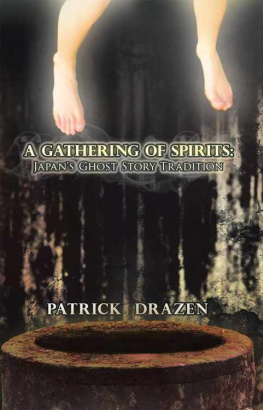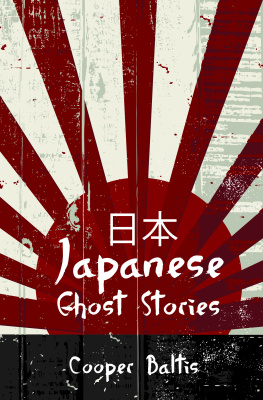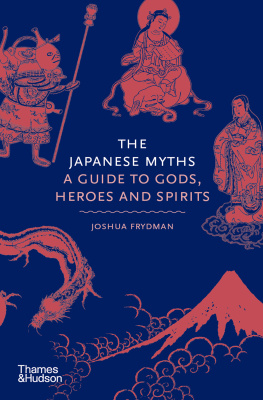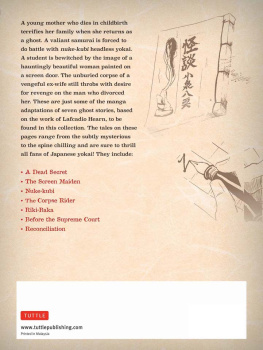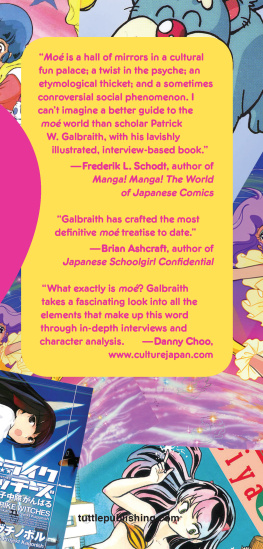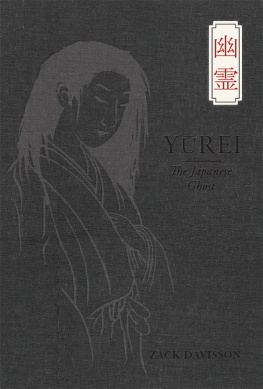A Gathering of Spirits: Japans Ghost Story Tradition
From Folklore and Kabuki to Anime and Manga
Patrick Drazen
iUniverse, Inc.
Bloomington
A Gathering of Spirits: Japans Ghost Story Tradition
From Folklore and Kabuki to Anime and Manga
Copyright 2011 by Patrick Drazen
All rights reserved. No part of this book may be used or reproduced by any means, graphic, electronic, or mechanical, including photocopying, recording, taping or by any information storage retrieval system without the written permission of the publisher except in the case of brief quotations embodied in critical articles and reviews.
iUniverse books may be ordered through booksellers or by contacting:
iUniverse
1663 Liberty Drive
Bloomington, IN 47403
www.iuniverse.com
1-800-Authors (1-800-288-4677)
Because of the dynamic nature of the Internet, any web addresses or links contained in this book may have changed since publication and may no longer be valid. The views expressed in this work are solely those of the author and do not necessarily reflect the views of the publisher, and the publisher hereby disclaims any responsibility for them.
Any people depicted in stock imagery provided by Thinkstock are models, and such images are being used for illustrative purposes only.
Certain stock imagery Thinkstock.
ISBN: 978-1-4620-2942-6 (pbk)
ISBN: 978-1-4620-2943-3 (ebk)
Printed in the United States of America
iUniverse rev. date:06/22/2011
Contents
CHAPTER 1: TO GET THINGS STARTED
01. Tell me
One night a policeman was walking through his usually quiet neighborhood. He was bored, he was almost asleep; his job had become almost automatic. He rounded one corner and saw someone on the ground a few yards ahead. He ran forward, and saw what appeared to be a woman who had fallen. Maybe the heel of her shoe had given way, or maybe she was drunk; he didnt care. At least it was a break in the routine.
Are you all right, maam? he called out as he approached.
Help me up, please, she said in a soft, very pretty voice. Her long hair hid her face. She reached a hand up; the policeman took her hand and helped her to her feet.
Thank you, the woman said, raising her head. As she did so, the policeman was able to get a better look at her face but instead he saw that she had no face. Where there should have been eyes, and a nose, and a mouth, there was nothingjust skin stretched smooth and blank as an egg.
The policeman fell back in shock and horror and ran up the street. He didnt even know where he was running to at first. After a minute, he saw the lights of a convenience store that stayed open all night. He burst into the store, and blurted out to the older man behind the counter what had just happened to him.
The cashier looked at the policeman for a second, smiled, then said, Tell me, officer; did she look like this? The cashier waved his hand in front of his own face, and his features vanished, leaving skin stretched smooth and blank as an egg.
xxx
This ghost story, about an encounter with a nopperabou (a faceless ghost), was acted out in the 1994 Studio Ghibli animated movie known as Ponpoko . It also appeared in print, in English, in 1904 in Lafcadio Hearns influential ghost story anthology Kwaidan . In fact, this story goes back hundreds of years, and is part of Japans long and rich spirit tradition. Stories about Japanese ghosts and other supernatural beings have been written, collected, adapted, reworked, and reinterpreted for centuries, and even the most modern ghost movies, manga (comics) and anime (animation) can refer back to ancient source material.
This book is loosely based on one of these grand and ghostly Japanese traditions, begun back in the Edo period : the hyaku monogatari . Literally the phrase means 100 stories, but the assumption is that these are all ghost stories. Heres how to play:
Gather some friends together one night, preferably a hot summer night, along with one hundred candles. Once all of the candles are lit, someone tells a ghost story. It can be short or long, historical or recent, frightening or humorous or morally instructiveas this book will show, Japanese ghost stories come in all sorts of flavors. When the first story ends, the storyteller blows out a candle. Then the next person tells a story, blows out a candle, and so on.
By the time the room is down to two or three lit candles, after several hours of ghost stories, everyones nerves should be on edge. When the last person finishes the last story and blows out the last candle, plunging the room into blackness, some say that a ghost, invisible in the candlelight, will appear. Others suggest that the party-goers count off in the pitch-black roomand one extra voice will answer.
My favorite thing about summer, writes Satsuki Igarashi, one of the cartoonists of the highly successful CLAMP manga collective, is the ghost stories . In fact, during summer breaks I would also watch a lot of afternoon TV, and the gossip shows often featured horror stories. Unlike in America, where ghost stories are often told in the autumn around Halloween, ghost stories in Japan are associated with summer for several reasons, and well look at them in greater detail later. For now, lets just say a major reason is because of the weather; Japan, except for the northernmost island of Hokkaido, has a tropical or semi-tropical climate. The summers get very mushi-atsui (humid and hot), and ghost stories were found long ago to be an effective way to send much-needed chills up and down ones spine.
Prepare for a sampling of Japanese ghosts and spirits, from sources that include the worlds oldest novel, the urban legends of contemporary Japanese schoolchildren, movies both classic and modern, anime, manga, and more. Some of the ghost stories will be actual ghost stories, designed to frighten and shock; sometimes, however, ghosts will appear in unlikely placesin romantic comedies, in sports anime, in domestic dramas, in school stories
First, though, we have to understand the ground-rules for dealing with the reality of spirits in Japan, especially the fact that reality itself is divided into the human world and the spirit world.
CHAPTER 2: THATS THE SPIRIT
T. R. Reid described the years he and his family lived in Tokyo while he was Asian Bureau Chief for the Washington Post in his book Confucius Lives Next Door . The title referred not just to the sage of China who lived 500 years before Christ, but also to the next door neighbors of the Reids, who embodied so many Confucian virtues. They were an elderly couple, the Matsudas, and one day Mrs. Matsuda passed away at age 78. As Reid placed flowers on the makeshift altar that had been erected in the Matsuda living room, Mr. Matsuda turned to a photograph of his late wife and told it matter-of-factly, Cho-Cho, its Reid-san.
Its tempting for a western reader in the 21 st century to dismiss this scene as the sentimental gesture of an elderly widower. Doing this, however, misses the point. Mr. Matsuda wasnt being sentimental, or senile, or ironic. He spoke to the picture of his wife in order to communicate with the spirit of his late wife; nothing more, nothing less.
This motif pops up often in Japans pop culture, and not always as practiced by elderly widowers. In one scene in the anime Princess Nine , a TV series about an elite girls high school that creates a baseball team to challenge the boys high schools, we see the girls star pitcher, fifteen-year-old Ryo Hayakawa, stopping before going to school to tell her father whats been happening. It doesnt matter that her fathers been dead for ten years; she still communicates with him through the Buddhist altar set up in the Hayakawa home (as it is in so many Japanese homes). In Ouran High School Host Club , the comic manga/anime by Bisco Hatori, heroine Haruhi Fujioka, another first-year high school student, consults with her dead mother via the altar in her apartment.
Next page
